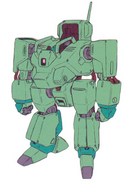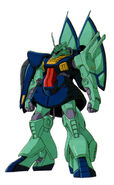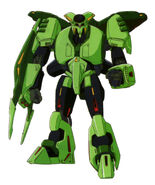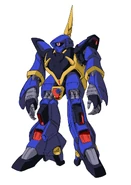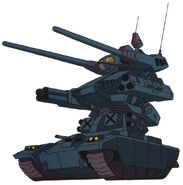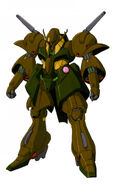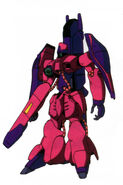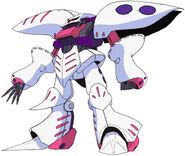| Please note that this is the Gundam Wiki's article on the TV series, Mobile Suit Zeta Gundam; if you are looking for the article on the titular mobile suit of this series then you should head to MSZ-006 Zeta Gundam. |
Mobile Suit Zeta Gundam (機動戦士
Synopsis[]
It is U.C.0087, seven years after the end of the One Year War. After the events of Operation Stardust, the Earth Federation establishes an elite counter-insurgency division called the Titans to hunt down the remaining pockets of Zeon remnants. The Titans become overzealous in their mission, start resorting to brutal methods to achieve their goals, and become nothing more than ruthless tyrants with an ambition to rule the Earth Sphere. Two anti-Titans resistance groups, the Anti-Earth Union Group (AEUG) and their Earth-bound counterparts Karaba (led by Hayato Kobayashi), form to unite the various existing small forces in the struggle against Titans. Their members consist of renegade soldiers of the Earth Federal forces, former soldiers of Principality of Zeon, and militia from space colonies. Most notable is Bright Noa, who returns as captain of the assault cruiser Argama, the flagship of AEUG space fleet, and Quattro Bajeena, who is really the legendary ace pilot Char Aznable, the "Red Comet".
Kamille Bidan is a troubled civilian seventeen-year old from Side 7's Green Noa 1 colony. His personal resentment towards the Titans results in him joining the AEUG. Quattro takes Kamille under his wings and becomes his mentor. The series also sees the partnership and cooperation between Kamille and Amuro, and the tension between Amuro and Char. Behind the frontline, the resistance group AEUG and Karaba are supported by many companies on Earth and in space, particularly the moon-based corporations. Besides financial support, the lunar manufacturing giant Anaheim Electronics also provides logistics and technical supports for AEUG, including spaceships, mobile suits, and munitions.
The series begins Quattro Bajeena raids the Titans military base in Green Noa 1 to acquire intelligence on a new mobile suit prototype, the "Black Gundams". Kamille, a hot-headed Newtype dissident, is caught up in the raid and helps AEUG steal the Mark-II. Eventually, he joins the AEUG, initially as the Mark-II pilot, then as the pilot of the new Ζ Gundam (made by Anaheim Electronics and based on Kamille's own design). Hayato Kobayashi and Amuro Ray meet up with them shortly after the AEUG descends on Earth to attack the Jaburo base but Amuro won't return to space. Both will stay on Earth with Karaba while Hayato's son, Katz, goes to space with Quattro.
Things are complicated further as Paptimus Scirocco, a "contract killer"/mobile suit developer from the Jupiter Energy Fleet (who, unbeknownst to his government handlers, is an extremely powerful Newtype) executes his own plan. He secretly conducts a coup d'état and takes over the Titans as part of his ambition to dominate the Earth Sphere. The war between Titans and AEUG will soon escalate as Haman Karn, the true leader of Axis Zeon, joins the war as well, leading to a three-way war. In the beginning, it is not clear which side the Axis Zeon is, as Haman's cunning plan is to play AEUG and Titans against each other and take advantage of the damage from the clash between them.
Episodes[]
| # | Episode Title | Japanese Airdate |
|---|---|---|
| 1 | The Black Gundam | 2 March 1985 |
| 2 | Departure | 9 March 1985 |
| 3 | Inside the Capsule | 16 March 1985 |
| 4 | Emma's Decision | 23 March 1985 |
| 5 | Father and Son | 30 March 1985 |
| 6 | To Earth | 6 April 1985 |
| 7 | Escape from Side 1 | 13 April 1985 |
| 8 | The Dark Side of the Moon | 20 April 1985 |
| 9 | A New Bond | 27 April 1985 |
| 10 | Reunion | 4 May 1985 |
| 11 | Entering the Atmosphere | 11 May 1985 |
| 12 | The Winds of Jaburo | 25 May 1985 |
| 13 | Shuttle Launch | 1 June 1985 |
| 14 | Amuro Flies Again | 8 June 1985 |
| 15 | Katz's Sortie | 15 June 1985 |
| 16 | Through the Haze of Darkness | 22 June 1985 |
| 17 | Hong Kong City | 29 June 1985 |
| 18 | Mirai Captured | 6 July 1985 |
| 19 | Cinderella Four | 13 July 1985 |
| 20 | The Heated Escape | 20 July 1985 |
| 21 | A Sign of Zeta | 27 July 1985 |
| 22 | The Eyes of Scirocco | 3 August 1985 |
| 23 | Moon Attack | 10 August 1985 |
| 24 | Counterattack | 17 August 1985 |
| 25 | Colony Drop | 24 August 1985 |
| 26 | The Ghost of Zeon | 31 August 1985 |
| 27 | Rendezvous With Char | 7 September 1985 |
| 28 | The Jupitris Infiltration | 14 September 1985 |
| 29 | Crisis at Side 2 | 21 September 1985 |
| 30 | Jerid's Desperate Attack | 28 September 1985 |
| 31 | Half Moon Love | 5 October 1985 |
| 32 | Unidentified Mobile Suits | 12 October 1985 |
| 33 | The Messenger from Axis | 19 October 1985 |
| 34 | The Call of Darkness | 26 October 1985 |
| 35 | Storm Over Kilimanjaro | 2 November 1985 |
| 36 | Forever Four | 9 November 1985 |
| 37 | The Day of Dakar | 16 November 1985 |
| 38 | Reccoa's Shadow | 23 November 1985 |
| 39 | By The Lake | 30 November 1985 |
| 40 | Activation of Gryps | 7 December 1985 |
| 41 | Awakening | 14 December 1985 |
| 42 | Goodbye, Rosammy | 21 December 1985 |
| 43 | Haman's Victory | 4 January 1986 |
| 44 | The Gate of Zedan | 11 January 1986 |
| 45 | Coming From the Heavens | 18 January 1986 |
| 46 | Scirocco Rises | 25 January 1986 |
| 47 | A Descent into the Maelstrom | 1 February 1986 |
| 48 | The Mirror of Rosamia | 8 February 1986 |
| 49 | Casualties of War | 15 February 1986 |
| 50 | Riders in the Skies | 22 February 1986 |
Compilation Movies: A New Translation[]
In celebration of Gundam's 25th anniversary (and also the 20th anniversary of Zeta Gundam), the 50-episode series was compiled into a new movie trilogy. According to Tomino, the movie series was created to fix some of the problems he identified in the Zeta TV series and to bring the 20-year-old series into a 21st-century context for the new generation now experiencing the increasingly commercialized series such as Mobile Suit Gundam SEED. The first movie, "Heirs to the Stars", opened on May 28, 2005, followed by "Lovers" on October 29, 2005, and "Love is the Pulse of the Stars" on March 6, 2006. The movies were a surprising hit, and went on to make almost 2 billion yen in box office revenue in total.
The compilations digitally remastered the TV series of Zeta Gundam with new footage. 33% of the first film was remastered footage, as well as around 70% of the second. Plot details such as the Argama's visit to the colony of 30 Bunch were changed to allow the film to flow more smoothly, unlike Tomino's previous Gundam film compilations. Also, other than Haman Karn's custom-type Gaza-C, some mobile suits that belong to the period designed after the TV version are also put into the movies such as GM Quel (Gundam 0083) as well as RX-121 Gundam TR-1 [Hazel] (Advance of Zeta).
Like the Mobile Suit Gundam movie trilogy, the majority of the original cast of Mobile Suit Zeta Gundam reprised their roles for these theatrical versions — with the exception of Satomi Arai replacing Miyuki Matsuoka as Fa Yuiry, Yukana Nogami replacing Saeko Shimazu as Four Murasame, Yuu Asakawa replacing Kayoko Fujii as Rosamia Badam, and Chizuru Ikewaki (Lovers)/Kaori Shimamura (Love is the Pulse of the Stars) replacing Yuko Mizutani as Sarah Zabiarov.
One of the largest changes made in the movies is the ending, as contrast to the original TV series, Kamille does not mentally break down due to Scirocco's mind-crippling attack. This change contributed greatly to the success at the box office since Gundam fans were curious about the new ending (though it is an expected ending from Tomino's previous comment on the movies). Furthermore, the ending also removed the Axis Zeon from the Earth Sphere, with some fans felt that this affected the Universal Century timeline considerably and displaced the original sequel to Zeta, Mobile Suit Gundam ZZ, as well as the follow-up movie Char's Counterattack. However, Tomino himself said this was not the case, and the Zeta movies were merely another take on the events. This was supported by Gundam Unicorn, which not only features several ZZ and Char's Counterattack mobile suits, but also characters and events related to both stories.
The trilogy performed exceptionally well in the Japanese box office, far more so than previous efforts by a Gundam series as well as many high profile animated films such as Steamboy. This success is even more remarkable considering the film is shown in a more limited number of theaters than usual. Heirs to the Stars, the first film of A New Translation, came in 3rd place at the box office on its opening week, and the second film Lovers received similar success. One possibility for this startling success is the recent wave of nostalgia, which desires a return to the serious story-telling style of older anime. However, a good deal of New Translation's viewing demographic are of a younger generation, ranging from the late teens to early twenties.
Even more surprising is the rather high amount of female viewers, reaching 30% of the overall viewing audience. Although the core demographic is 20- to 32-year-old males still, many see this as a reminder of just how well crafted the original Gundam series were. Tomino himself, who had been wrought with a recent string of financially failed series, posted a personal "Thank you" to fans and casual moviegoers alike on A New Translation's official website.
In 2006, Bandai Entertainment acquired the rights to the U.S release of the Mobile Suit Zeta Gundam: A New Translation movie trilogy. The movies were released as a three-pack entitled Mobile Suit Gundam Zeta: Movie Complete Collection on July 6, 2010. The collection contains all three films on three DVDs with English subtitles and in Japanese with a choice of either 2.0 stereo or 5.1 surround sound.
Compiled Episodes[]
- Episode 1: The Black Gundam
- Episode 2: Departure
- Episode 3: Inside the Capsule
- Episode 4: Emma's Decision
- Episode 5: Father and Son
- Episode 6: To Earth
- Episode 11: Entering the Atmosphere
- Episode 12: The Winds of Jaburo
- Episode 13: Shuttle Launch
- Episode 14: Amuro Flies Again
- Episode 15: Katz's Sortie
- Episode 16: Through the Haze of Darkness
- Episode 17: Hong Kong City
- Episode 18: Mirai Captured
- Episode 19: Cinderella Four
- Episode 20: The Heated Escape
- Episode 21: A Sign of Zeta
- Episode 22: The Eyes of Scirocco
- Episode 23: Moon Attack
- Episode 24: Counterattack
- Episode 25: Colony Drop
- Episode 30: Jerid's Desperate Attack
- Episode 31: Half Moon Love
- Episode 32: Unidentified Mobile Suits
- Episode 33: The Messenger from Axis
- Episode 38: Reccoa's Shadow
- Episode 39: By The Lake
- Episode 40: Activation of Gryps
- Episode 43: Haman's Victory
- Episode 44: The Gate of Zedan
- Episode 45: Coming From the Heavens
- Episode 46: Scirocco Rises
- Episode 47: A Descent into the Maelstrom
- Episode 49: Casualties of War
- Episode 50 (Final): Riders in the Skies
Production[]
Among the returning staff members from Mobile Suit Gundam were original creator and director, Yoshiyuki Tomino, character designer Yoshikazu Yasuhiko and mechanical designer Kunio Okawara. Also providing mechanical designs were Mamoru Nagano (whom Tomino had worked with on Heavy Metal L-Gaim), and Kazumi Fujita.
Release[]
The series was originally aired by Nagoya Broadcasting Network (and it's sister ANN stations), rerun on the anime satellite television network, Animax, across Japan and later its respective networks worldwide, including Southeast Asia, East Asia, Latin America, and other regions.
In 2004, after almost 2 years of delays and failed TV and merchandising deals, Bandai released a limited edition Zeta Gundam box set with both dubbed English and original Japanese audio tracks. The English dub was done by Ocean Productions with its Blue Water Studios talent pool.
Due to Bandai not having rights to the theme songs outside of Asia, the opening and closing sequences were altered, using incidental music in place of the original theme music. The English subtitles were criticized as inaccurate, and appeared to be based on the script for the English dub, rather than a direct translation of the original Japanese script. Bandai corrected the subtitles to a properly translated version for the later DVD release in 5 cases with 2 discs each, but has never officially recalled or offered to replace the box-set discs.The box-set included pencil sharpener collectibles and a 48-page booklet and poster. Each DVD in the Bandai Region 2 release contains five episodes as opposed to the standard three to six usually seen in single box releases.
After Sunrise teamed up with Right-Stuf! & Nozomi Entertainment, the plans for a Blu-ray release began. Again, due to licensing issues, this release and subsequent English releases so far lack are the original Japanese opening themes. Collection 1, containing episodes 1 to 25 was released on March 1, 2016.[1][2] On February 16, they also announced the release of a three-disc DVD set, each one containing one of the A New Translation compilation movies.[3] Anime Limited released the Region B Collection 1 Blu-ray on August 29, 2016. Those that had pre-ordered from their approved retailers prior to 12:00 BST June 22, 2016 also received a limited edition box featuring art of the MSZ-006 Zeta Gundam with a space inside for the collection 2 Amaray case and artbook.[4][5]
On April 5, 2017, Gundam.Info announced that it would be streaming episodes on its YouTube channel for free, with 3 to 5 episodes per week. Episodes 1 to 5 were uploaded on April 7 12:00 PM JST.[6]
Trivia[]
- Love is the Pulse of the Stars was Hirotaka Suzuoki's last role as Bright Noa in the Gundam series. Suzuoki died of lung cancer on August 6, 2006 at the age of 56.
- Mobile Suit Zeta Gundam established the eventual trend of the lead pilot, with some exceptions, getting a generally-improved Gundam as main mobile suit at some point of the series, as contrast to the first Gundam series. This idea was probably extracted from Tomino's original novelisation, which had Amuro replace the RX-78-2 Gundam with the Gundam G3.
- The melodies of the TV series' two opening themes and sole ending theme were written by American pop singer/songwriter Neil Sedaka. "Zeta - Toki wo Koete" was based upon the song "Better Days are Coming" from Sedaka's 1972 album Solitaire, while "Hoshizora no Believe" was adapted from the song "Bad and Beautiful" from the 1976 album Steppin' Out. Additionally, "Mizu no Hoshi e Ai wo Komete" was derived from an unreleased song entitled "For Us to Decide".
- Apparently, the mecha design of the Zeta Gundam itself was a competition among the series designers, with Kazumi Fujita eventually winning the competition, leading to his distinctive Zeta Gundam being animated. However, rejected designs for the Zeta Gundam were animated once they were reworked, examples being the MSN-00100 Hyaku Shiki and the MRX-009 Psycho Gundam.

Walker Galia's cameo
- During episode 13, a mysterious red mobile suit can be seen in Hayato's museum. It is altered version of Walker Galia, the second protagonist mech from Combat Mecha Xabungle, another Sunrise's mecha anime directed by Yoshiyuki Tomino.
- Mobile Suit Zeta Gundam won the second place in Animage's Anime Grand Prix Award in 1985. In the same year, one of its character, Four Murasame was selected as the favorite female anime character of the year.
Opening, ending and insert songs[]
OST[]
Main article: Symphonic Suite Z-Gundam
The main soundtrack for the series was composed by Shigeaki Saegusa.
TV series[]
Opening:
- Zeta - Toki wo Koete (Z・刻をこえて; Zeta - Transcending Times) by Mami Ayukawa (Eps. 1-24)
- Mizu no Hoshi e Ai wo Komete (水の星へ愛をこめて; From the Blue Planet with Love) by Hiroko Moriguchi (Eps. 25-50)
Ending:
- Hoshizora no Believe (星空のBelieve; Believe in the Starry Sky) by Mami Ayukawa
Insert:
- Gin'iro Doresu (銀色のドレス; Silver Dress) by Hiroko Moriguchi (Ep. 20)
US DVD songs:
- Zeta no Kodō ~ Zeta Gundam (Ζの鼓動~Ζガンダム; Zeta's Pulse~Zeta Gundam) by Shigeaki Saegusa (Opening)
- Gurīn Noa no Shōnen ~ Arata na Sekai (グリーン・ノアの少年~新たな世界; Boy from Green Noa ~ A New World) by Shigeaki Saegusa (Ending)
Compilation Movies[]
Heirs To The Stars:
- Metamorphoze by Gackt (Opening)
- Kimi ga Matteiru Kara (君が待っているから; Because you're Waiting) by Gackt (Ending)
Lovers:
- Mind Forest by Gackt from his "Crescent" Album (Ending)
Love is the Pulse of the Stars:
- Love Letter by Gackt (Insert song that starts shortly before the end credits and continues as they start to roll)
- Dybbuk by Gackt (Ending, plays after Love Letter)
- All of the songs above were complied and released in Gackt's tribute album to Gundam and Z Gundam, 0079-0088
Cast[]
| Character | Japanese Actor | English Actor |
|---|---|---|
| Kamille Bidan | Nobuo Tobita | Jonathan Lachlan-Stewart |
| Char Aznable | Shuichi Ikeda | Tom Edwards |
| Bright Noa | Hirotaka Suzuoki | Dave Kelly |
| Emma Sheen | Maya Okamoto | Lisa Christie |
| Reccoa Londe | Masako Katsuki | Meredith Taylor-Parry |
| Fa Yuiry | Miyuki Matsuoka (TV) Satomi Arai (Movies) |
Angie Beers |
| Four Murasame | Saeko Shimazu (TV) Yukana Nogami (Movies) |
Carol-Anne Day |
| Henken Bekkener | Jurota Kosugi | David Pettitt |
| Blex Forer | Takaya Fujido (TV) Koji Ishii (Movies) |
Byron Close |
| Amuro Ray | Toru Furuya | Matthew Erickson |
| Wong Lee | Yukimasa Natori (TV) Kazumi Tanaka (Movies) |
Dean Galloway |
| Paptimus Scirocco | Bin Shimada | Jonathan Love |
| Jerid Messa | Kazuhiko Inoue | Ethan Cole |
| Mouar Pharaoh | Yoshiko Sakakibara | Jennifer Holder |
| Jamitov Hymen | Tomomichi Nishimura | Steve Olson |
| Bask Om | Daisuke Gori | Noah Umholtz |
| Yazan Gable | Houchu Ohtsuka | Corby Proctor |
| Sarah Zabiarov | Yuko Mizutani (TV) Chizuru Ikewaki (Movie 2) Kaori Shimamura (Movie 3) |
Maizun Jayoussi |
| Rosamia Badam | Kayoko Fujii (TV) Yu Asakawa (Movies) |
Valerie Howell |
| Haman Karn | Yoshiko Sakakibara | Jennifer Bain |
| Lila Milla Rira | Kimie Sawaki (TV) Mayumi Asano (Movies) |
Mechanics[]
AEUG/Karaba[]
Mobile Weapons[]
Vehicles and Support Units[]
- Argama-class
- Space Boat
- Beechcraft Model D17 "Comet"
- Dodai Kai
- Flying Armor
- FXA-05D G-Defenser
- Garuda-class
- H.L.L.V.
- Hohsenka
- Irish-class
- Salamis Kai-class
- Shackles
- Suit Carrier
- Transport Ship
- XB-70 Valkyrie
Titans/Earth Federation Forces[]
Mobile Weapons[]
Vehicles and Support Units[]
Axis Zeon[]
Mobile Weapons[]
Vehicles and Support Units[]
Anaheim Electronics[]
Vehicles and Support Units[]
Principality of Zeon[]
Mobile Weapons[]
Vehicles and Support Units[]
Republic of Zeon[]
Mobile Weapons[]
Vehicles and Support Units[]
Gallery[]
See also[]
Prequels[]
- Mobile Suit Gundam
- Mobile Suit Gundam 0083: Stardust Memory
- Mobile Suit Zeta Gundam: Four Story - And to a soldier…
Adaptations[]
- Mobile Suit Gundam Zeta (Novel)
- Mobile Suit Gundam Zeta (Manga)
- Mobile Suit Zeta Gundam Define
- Mobile Suit Z Gundam Heir to the Stars
- Mobile Suit Z Gundam II Lovers
- Mobile Suit Z Gundam III Love is the Pulse of the Stars
Compilations[]
- Mobile Suit Zeta Gundam: A New Translation - Heir to the Stars
- Mobile Suit Zeta Gundam: A New Translation II - Lovers
- Mobile Suit Zeta Gundam: A New Translation III - Love Is the Pulse of the Stars
Side Stories[]
- Side Story of Gundam Zeta
- Mobile Suit Zeta Gundam Sayonara
- Mobile Suit Zeta Gundam: Day After Tomorrow - From Kai Shiden's Report
- Mobile Suit Zeta Gundam 1/2 UC 0087: Another Story
- Mobile Suit Gundam: The Blazing Shadow
- Zeta Gundam Mobile Suit Variations
Video Games[]
- Mobile Suit Z Gundam - Hot Scramble (1986)
- Mobile Suit Zeta Gundam, First part – Beat of Zeta (1997)
- Mobile Suit Z Gundam (Game) (1997)
- Mobile Suit Gundam: Gundam vs. Zeta Gundam (2004)
- Mobile Suit Gundam Zeta: Battle Typing Game (2005)
Sequel[]
Notes[]
- Mobile Suit Zeta Gundam differed from its preecessor in a number of ways:
- Perhaps the most obvious is that The Earth Federation's elite Titans task force emerge as the totalitarian parallel to what the Principality of Zeon was in the original show, effectively making the heroic faction of the previous story into the main villains. Consequently, former Federation pilots like Amuro Ray, Bright Noa, Hayato Kobayashi, and Kai Shiden fight on the same side as Char Aznable as part of the AEUG-Karaba alliance against their former allies in the Federation.
- Despite the cast's significant role in the One Year War, Mobile Suit Gundam was initially more or less episodic and focused on its cast's personal reactions to the setting. From its first episode, Zeta Gundam is immediately more concerned with politics and the characters have much greater direct influence on the war.
- Hugely successful, Zeta Gundam would prove influential on numerous subsequent Gundam series:
- Unlike in Mobile Suit Gundam, the Gryps Conflict develops into a three-way war between AEUG, Titans, and later, Haman Karn's Axis Zeon, which culminated in the final battle Operation Maelstrom. This set up is seen again in 1995's New Mobile Report Gundam Wing as a three-way conflict between the Gundam Pilots, the World Nation (led by Treize Khushrenada), and White Fang (led by Zechs Merquise) develops, as well as in 1996's After War Gundam X with a three way battle between the Earth Forces, Space Forces and the main characters as a separate force. This would also return for 2002's Mobile Suit Gundam SEED, which saw the Earth Alliance, ZAFT, and Orb Union vie against each other and 2007's Mobile Suit Gundam 00 where the series begins in a period of cold war between the Union of Solar Energy and Free Nations, Advanced European Union, and Human Reform League.
- Gundam 00 would later follow in Zeta's footsteps in an entirely different way, following its lead of transitioning the seemingly heroic Earth Sphere Federation into a dystopian state controlled by a corrupt elite peacekeeping force, the A-Laws. In order to defeat them, the space based main characters, Celestial Being, must team up with the Earthborn resistance, Katharon, just like in Zeta Gundam. The A-Laws borrow heavily from the blueprint that the Titans laid out, featuring similar infighting, use of excessive force, and success in taking control of the larger military.
- Zeta Gundam put a huge emphasis on Mobile Suits that could transform and travel between Earth and outer space. Later series would continue to build upon this, with many giving lead characters transforming Gundam-type Mobile Suits.
- Char Aznable plays the role of mentor to new protagonist and lead character Kamille Bidan, effectively becoming the second lead character. This mentor-protege relationship was well received and affected numerous later productions, ensuring that Quattro Bajeena became a staple archetype just as the Char persona would.
- Of the four Gundam television series that take place in Universal Century, (Mobile Suit Gundam, Zeta Gundam, ZZ Gundam and Victory Gundam), Zeta Gundam is the only show that does not incorporate the Core Block System with its Gundams, where the Gundams break apart and reveal a hidden Core Fighter doubling as the cockpit. Instead it uses a fully-transformable system, which was very popular in 80's Real Robot anime. The anime Super Dimension Fortress Macross was the earliest example of this.
- Particularly towards the end of the series, Zeta Gundam features a very high number of casualties on all sides, including many named characters. The series' willingness to kill off major characters solidified Yoshiyuki Tomino's "Kill 'Em All" reputation.
- Mobile Suit Zeta Gundam was the second Gundam TV series airing in Showa Era.
- The show is referenced in Great Teacher Onizuka, where it is mentioned by the Gundam nerds and they describe fans of Zeta Gundam as "craving for destruction". In the anime, one of these nerds is ironically voiced by Tōru Furuya.
External links[]
- Zeta Gundam on GundamOfficial
- Zeta Gundam Official Website (Japanese)
- AnimeChannel's Mobile Suit Z Gundam Playlist on Youtube
References[]
| Preceded by: Mobile Suit Gundam 0083: Stardust Memory |
Chronological order 0087 U.C. – 0088 U.C. |
Succeeded by: Mobile Suit Gundam ZZ |

